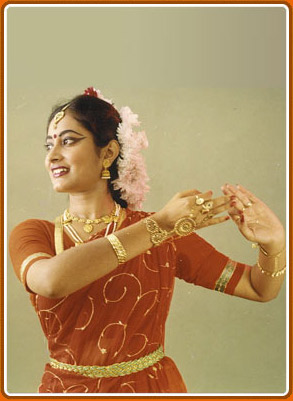| |
About Kathak & Dr. Anindita Sen
 Kathak is a North Indian classical dance which has a long past nurtured in the holy precincts of the Hindu temples. Kathak has over the years attained refinement and enriched itself with various hues and embellishments. Kathak originates from the word "katha," which means stories. This was evidenced in the ancient Sanskrit text, "Sidhhanta Kaumudi," by Panini.
Kathak is a North Indian classical dance which has a long past nurtured in the holy precincts of the Hindu temples. Kathak has over the years attained refinement and enriched itself with various hues and embellishments. Kathak originates from the word "katha," which means stories. This was evidenced in the ancient Sanskrit text, "Sidhhanta Kaumudi," by Panini.
There is a popular saying "Katha kaahe so kathak." One who tells a story is a "kathakar," or storyteller. The concept of a kathakar impersonating various characters in a story has been referred to by Bharata in Natya Shastra (one of the oldest treaties of Indian classical dance). These story tellers traveled to different parts of the country telling and enacting the mythological Indian tales through mime, hand gestures and facial expressions.
Kathak as an art form was handed down from one generation to the next in a hereditary manner as an oral tradition. Developed over the years, and given by father to son, the skills, techniques, and knowledge of the art of Kathak resulted into two main schools (or gharanas): Lucknow and Jaipur.
Held within a well-defined system of artistic values, the schools display salient features that distinguish them. However, with the passage of time, the demarcations are fast-disappearing with free exchange between the gharanas.
The third well-known Kathak gharana is known as Benaras gharana.
|
| |
From the 16th century onwards, Kathak was patronized in the courts of the Mughal emperors. Hence this dance form contains a blend of both Hindu spiritualism and aspects of Persian dances. Kathak is also unique in this respect and differs from all other classical Indian dance forms. Kathak combines fast footwork, intricate and graceful hand movements with repetitive pirouettes. These nuances also sets it apart from other Indian dance forms. Kathak is often referred as the Flamenco of the East due to the intricate footwork that is common to both of these dance forms.
Similar to all other Indian Classical dance forms, Kathak has an expressional component (Nritya), a pure dance component (Nritta) and a dramatics component (Abhinaya). The pure dance component includes execution of thoras, tukras, and parans, which include mnemonic syllables and clear footwork while the Nritya component involves the execution of the graceful gatnikas.
About Dr. Anindita Sen
 Dr. Anindita Sen is the founder, President and artistic director of Nrityangan Kathak Academy in Carmel, IN. She has trained in the Lucknow gharana of Kathak in Kolkata, India for 15+ years. Her guru Shrimati Amita Dutt herself trained under Pandit Birju Maharajji who is considered one of the foremost exponents of Kathak today. Anindita has performed and given lecture demonstrations in several cities in India, the US, and the UK.
Dr. Anindita Sen is the founder, President and artistic director of Nrityangan Kathak Academy in Carmel, IN. She has trained in the Lucknow gharana of Kathak in Kolkata, India for 15+ years. Her guru Shrimati Amita Dutt herself trained under Pandit Birju Maharajji who is considered one of the foremost exponents of Kathak today. Anindita has performed and given lecture demonstrations in several cities in India, the US, and the UK.
Even though Anindita is a scientist by profession, Nrityangan arose from her innate passion for Kathak. Through her dance school, Anindita has been imparting Kathak training since 1994 to several students in Iowa, North Carolina, and currently in Carmel, IN. Anindita is active in the Indianapolis cultural community. Since 2004 she and/or her students have performed at several local and regional events which include the following:
• The North America Bengali Conference (Madison Square Garden, NYC)
• IAI Diwali event at the Murat
• IAI India Day festival
• Indiana State Fair
• Indiana International Festival
• Asian Fest sponsored by the Asian American Alliance of Indiana
• DePauw University Multicultural and Community Life event
• Hindu Temple of Central Indiana sponsored Temple Fest and Holi events
• Sangam organized by Lilly India Network
• Navrang organized by Hindu Temple of Central Indiana
• Children's Museum of Indianapolis- International Dance Day
• Fundraiser for the Jackson Center for Conductive Education
• Indiana Deaf School
• Heartland Film Festival-Journey to India-Opening night gala
• Eli Lilly Multicultural event
• Tri-State Durga Puja
• Carmel International Festival
In 2014, Anindita was instrumental in organizing and hosting a live performance by Padmavibhushan Pandit Birju Maharajji, Saswati Sen and other members of the Kalashram (New Delhi) troupe. Anindita has also partnered with Clowes Memorial Hall of Butler University to bring Ragamala Dance Theater from Minneapolis, MN to Indianapolis in 2015. Between 2011 to 2015, Anindita has served as a faculty member at the Academy of Gregory Hancock Dance Theater (AGHDT) and is currently a member of the Board of Directors of GHDT. Anindita is a Director of Regulatory Affairs at Eli Lilly and Company and has been working there for the past 18 years.
|
|

